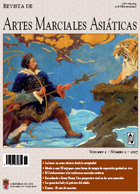Miedo a caer. El taijiquan como forma de terapia de exposición gradual en vivo
DOI:
https://doi.org/10.18002/rama.v2i2.299Resumo
Não há resumo disponível em Português
Downloads
Métricas alternativas
Referências
ASMUNDSON, G., NORTON, P., & VLAEYEN, J. (2004). Fear-avoidance models of chronic pain: an overview. En G. Asmundson, J. Vlaeyen, & G. Crombez (Eds.), Understanding and treating fear of pain. New York: Oxford University Press.
BOERSMA, K., LINTON, S., OVERMEER, T., JANSSON, M., VLAEYEN, J., & DE JONG, J. (2002). Lowering fear-avoidance and enhancing function through exposure in vivo: A multiple baseline study across six patients with back pain. Pain, 108, 8-16.
CHAMBERLIN, M., FULWIDER, B., SANDERS, S., & MEDEIROS, J. (2005). Does fear of falling influence spatial and temporal gait parameters in elderly persons. The Journals of Gerontology. Series A, Biological sciences and medical sciences, 60, 1163-1167.
DELBAERE, K., CROMBEZ, G., VANDERSTRAETEN, G., WILLEMS, T., & CAMBIER, D. (2004). Fear-related avoidance of activities, falls, and physical frailty. A prospective community-based cohort study. Age and Ageing, 33, 368-373.
HAAS, C., GREGOR, R., WADDELL, D., OLIVER, A. SMITH, D., FLEMMING, R., & WOLF, S. (2004). The influence of Tai Chi training on the centre of pressure trajectory during gait initiation in older adults. Archives of Physical Medicine and Rehabilitation, 85, 1593-1598.
HADJISTAVROPOLOUS, T., & CARPENTER, M. (2006). Fear of pain and fear of falling in the elderly. Presentación en la Canadian Pain Society 2006 Annual Conference, Edmonton, 14 y 15 de junio. Edmonton, AB.
HONG, J. (2006). Chen style Taijiquan practical method (Z. H. Chen, Trad.). Edmonton, Canada: Hunyuantaiji press.
LAJOIE, Y., & GALAGHER, S. (2003). Predicting falls within the elderly community: of postural sway, reaction time, the Berg balance scale, and the Activities-specific Balance Confidence Scale for comparing fallers and non-fallers. Archives of Physical Medicine and Rehabilitation, 85, 1593-1598.
MAKI, B., HOLLIDAY, P., & TOPPER, A. (1991). Fear of falling and postural performance in the elderly. Journal of Gerontology, 46, 123-131.
MCGIBBON, C., KREBS, D., PARKER, S., SCARBOROUGH, D., WAYNE, P., & WOLF, S. (2005). Tai Chi and vestibular rehabilitation improve vestibulopathic gait via different neuromuscular mechanisms: preliminary report. BMC Neurology, 5, 1471-1483.
MEYERS, A., POWELL, L., MAKI, B., HOLLIDAY, P., BRAWLEY, L., & SHERK, W. (1996). Psychological indicators of balance confidence: Relationship to actual and perceived abilities. Journal of Gerontology, 51, 37-43.
POWELL, L., & MYERS, A. (1995). The activities-specific balance confidence (ABC) scale. Journal of Gerontology, 50, 28-34.
SHUMWAY-COOK, A., GRUBER, W., BALDWIN M., & LIAO, S. (1997). The effect of multidimensional exercises and balance, mobility and fall risk in community-welling older adults. Physical Therapy, 77, 46-57.
TAGGERT, H. (2002). Effects of Tai Chi exercise on balance, functional mobility, and fear of falling among older women. Applied Nursing Research, 15, 235-242.
TIDEIKSAAR, R. (1997). Falling in the old age: Its prevention and management (2nd Ed). New York: Springer.
TINETTI, M., MEDES DE LEON, C., DOUCETTE, J., & BAKER, D. (1994). Fear of falling and fall-related efficacy in relationship to functioning among community-living elders. Journal of Gerontological Medical Science, 49, 140-147.
TINETTI, M., RICHMAN, D., & POWELL, L. (1990). Falls efficacy as a measure of fear of falling. Journal of Gerontological Psychologial Science, 48, 239-243.
TINETTI, M. & WILLIAMS, C. (1997). Falls, injuries due to falls, and the risk of admission to a nursing home. The New England Journal of Medicine, 337, 1279- 1284.
TSANG, W. W., WONG, V. S., FU, S. N., HUI-CHAN, C. W. (2004). Tai Chi improves standing balance control under reduced or conflicting sensory conditions. Archives of Physical Medicine, 85, 129-137.
VLAEYEN, J., DE JONG, J., LEEUW, M., & CROMBEZ, G. (2004). Fear reduction in chronic pain: graded exposure in vivo with behavioral experiments. En G. Asmundson, J. Vlaeyen, & G. Crombez (Eds.), Understanding and treating fear of pain. New York: Oxford University Press.
WAYNE, P., KREBS, D., WOLF, S., GILL-BODY, K., SCARBOROUGH, D., MCGIBBON, C., & KAPTCHUK, T. (2004). Can Tai Chi improve vestibular postural control? Archives of Physical Medicine and Rehabilitation, 85, 142- 152.
WOLF, S., BARNHART, H., KUTNER, N., MCNEELY, E., COOGLER, C., & XU, T. (1996). Reducing frailty and falls in older persons: An investigation of Tai Chi and computerized balance training. Journal of the American Geriatric Society, 44, 889-903.
WOLF, S., COOGLER, C., & XU, T. (1997). Exploring the basis for Tai Chi Chuan as a therapeutic exercise approach. Archives of Physical Medicine and Rehabilitation, 85, 886-892
Downloads
Publicado
Como Citar
Edição
Secção
Licença
Direitos de Autor (c) 2012 Shane Kachur, R. Nicholas Carleton, Gordon Asmundson

Este trabalho encontra-se publicado com a Licença Internacional Creative Commons Atribuição-NãoComercial-CompartilhaIgual 4.0.
Os autores que publicam nesta Revista estão de acordo com os seguintes termos:
- Os autores cedem, de forma exclusiva, os direitos de exploração (reprodução, distribuição, comunicação pública, transformação) à Universidade de Léon, podendo estabelecer, em separado, acordos adicionais para a distribuição não exclusiva da versão do artigo publicado na Revista (por exemplo: alojar no repertório institucional ou publicá-lo num livro), com o reconhecimento da publicação inicial nesta Revista.
- O trabalho encontra-se na Creative Commons Attribution-Non Commercial-Share Alike 4.0 International License. Pode-se consultar aqui o resumo e o texto legal da licença.
- Permite-se, e sugere-se, que os autores difundam electronicamente as versões pré-impressão (versão antes de ser avaliada) e pós-impressão (versão avaliada e aceite para publicação das suas obras antes da sua publicação), favorecendo a sua circulação e difusão, e com ela o possível aumento da sua citação e alcance pela comunidade académica.











